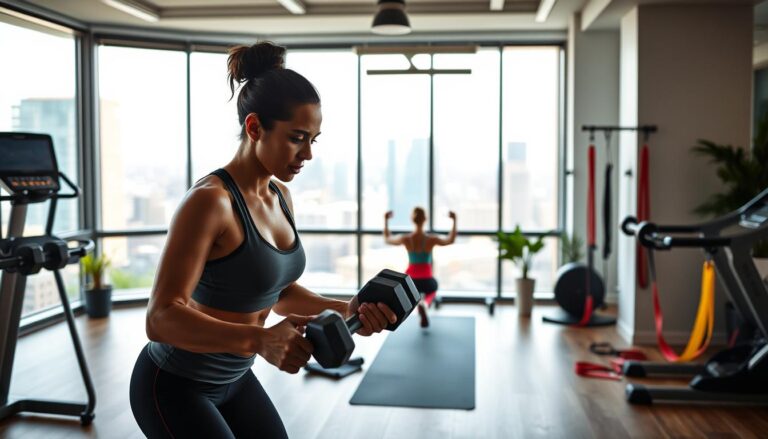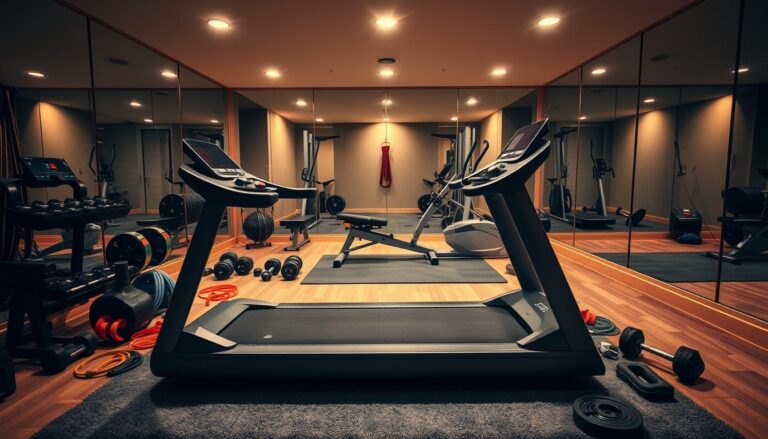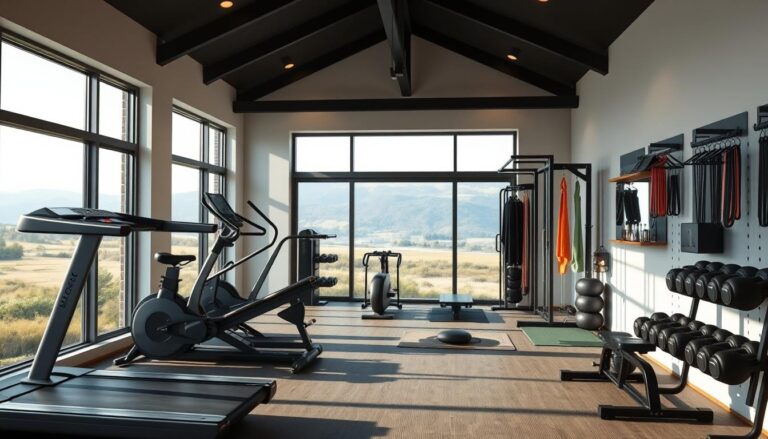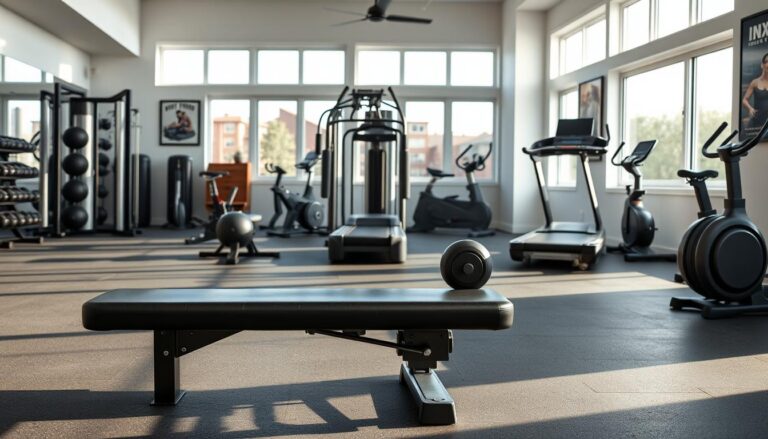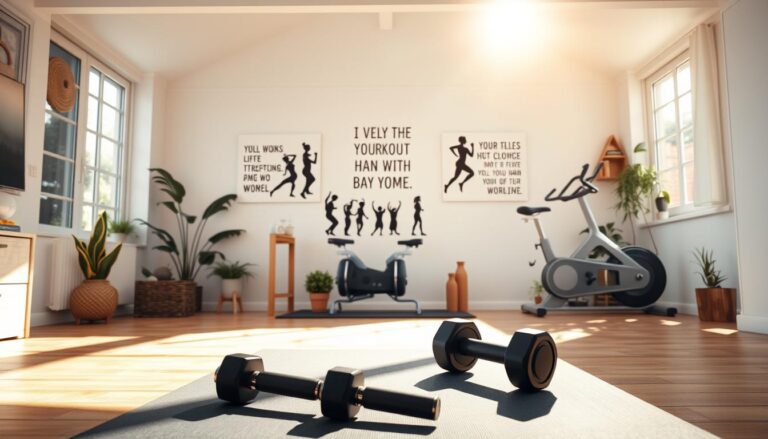5 Proven Fitness at Home Exercises That Actually Work
Staying fit doesn’t need a gym membership. You can reach your health goals from home with the right home workout routines.
Effective home exercises often use simple tools like dumbbells and resistance bands. Fitness experts love these for working out many muscles at once.
Adding these exercises to your routine boosts your fitness. The secret is to choose exercises that work many muscles at once. This makes your workouts more effective.
Key Takeaways
- Home workout routines can be just as effective as gym workouts.
- Dumbbells and resistance bands are versatile and effective tools.
- Targeting multiple muscle groups at once is key to efficient workouts.
- Consistency is crucial for seeing real results.
- Simple equipment can be used to achieve significant fitness gains.
Why Home Workouts Are More Popular Than Ever
Home fitness routines are more popular than ever. This is because they are convenient, accessible, and allow for a full-body workout without gym memberships. People enjoy working out at home because it fits into their busy lives and is comfortable.
Convenience and Accessibility Factors
Home workouts are convenient because they fit into your schedule. You don’t have to waste time commuting to a gym. Plus, you can work out whenever you want, making it easier to stay on track.
Home workouts are also accessible. You can do bodyweight exercises anywhere. They are great for all fitness levels. You can also use dumbbells and resistance bands for a more effective workout without big gym equipment.
Cost-Effectiveness of Home Fitness
Home workouts are also cost-effective. You don’t need expensive gym memberships or special equipment. Basic gear like dumbbells and resistance bands can be a good investment for long-term fitness.
Choosing home workouts can save you money. Yet, you still get to enjoy effective home exercises that boost your fitness and health.
Essential Equipment for Effective Home Workouts
Effective home exercises need just the right tools. This makes it simple to stay fit from home. The right equipment can boost your home workout plans and help you reach your fitness goals faster.
Dumbbells: The Versatile Home Fitness Tool
Dumbbells are key in many home exercise programs. They’re versatile and effective. You can use them for many strength-training exercises, working out different muscle groups.
Choosing the Right Weight for Your Fitness Level
It’s important to pick dumbbells that match your fitness level. Beginners should start with lighter weights. As you get stronger, you can increase the weight.
Resistance Bands: Portable Strength Training
Resistance bands are great for at home workout ideas. They’re light, easy to carry, and come in different resistance levels.
Different Types of Bands and Their Uses
There are many types of resistance bands, like loop, tube, and figure-eight bands. Each has its own uses and benefits. They let you do a wide range of exercises.
Other Helpful Equipment to Consider
Other tools like exercise balls, jump ropes, and yoga mats can also help. They add variety to your workouts and prevent getting stuck in a routine.
Benefits of Consistent Home Exercise Routines
Regular home workouts bring many benefits for both body and mind. Adding effective home exercises to your daily routine can greatly improve your health.
Physical Health Improvements
Home exercise routines can greatly improve your physical health. Using dumbbells and resistance bands, you can build muscle and increase energy. Strength training at home can also make you more physically fit.
Key physical benefits include better heart health, more flexibility, and stronger muscles. By following home fitness tips and doing the best exercises for home fitness, you can get a stronger, healthier body.
Mental Health Benefits
Home exercise routines also boost mental health. Regular exercise can lower stress and anxiety, improve mood, and enhance mental well-being. By adding home workout routines to your daily life, you can see these benefits for yourself.
Exercising at home can also make you feel accomplished and boost your self-esteem. This can lead to a more positive outlook on life. By making home exercise a regular part of your routine, you can become a healthier, happier person.
5 Proven Fitness at Home Exercises That Actually Work
Working out at home is easy and effective with the right moves. There are many exercises to choose from. It’s key to pick ones that science supports and fit well into your daily routine.
Scientific Evidence Behind These Exercises
Squats, lunges, and push-ups work many muscles at once. Research proves that using dumbbells and resistance bands boosts muscle strength and endurance.
Key benefits include:
- Increased muscle mass
- Improved bone density
- Enhanced metabolic rate
How to Maximize Results from Home Workouts
To get the best from home workouts, focus on correct form and technique. Dumbbells and resistance bands add variety and challenge.
Here are some tips to maximize your results:
- Start with lower weights and gradually increase the load as you become stronger.
- Incorporate a mix of upper and lower body exercises to ensure a balanced workout.
- Consider a home workout plan that includes a variety of exercises to keep your routine interesting and prevent plateaus.
Exercise1: Dumbbell Squats for Lower Body Strength
Dumbbell squats are great for strengthening your legs and glutes. They work on the quadriceps, hamstrings, and glutes. This makes them a top choice for effective home exercises for your lower body.
Proper Form and Technique for Maximum Results
To get the most from dumbbell squats, keep your form right. Stand with your feet shoulder-width apart, holding dumbbells. Lower down into a squat, keeping your back straight and knees behind your toes.
Push through your heels to stand up again. Proper technique is vital for avoiding injuries and getting the best results.
Variations for Beginners to Advanced Fitness Levels
Dumbbell squats can be adjusted for any fitness level. Beginners can start with bodyweight squats or use lighter dumbbells. Those more advanced can lift heavier weights or try different squats like sumo or narrow-stance squats.
- Bodyweight squats
- Dumbbell sumo squats
- Narrow-stance dumbbell squats
Common Mistakes to Avoid for Safety and Effectiveness
Don’t let your knees go past your toes, don’t squat too little, and keep your back straight. Focus on controlled movements and use your core. Safety and effectiveness depend on proper form.
Exercise2: Resistance Band Push-Ups for Upper Body Development
Resistance band push-ups are a great way to work your upper body. They make push-ups more challenging and help build muscle. This leads to stronger muscles and better overall fitness.

Proper Form and Technique for Chest and Arm Engagement
To get the most out of resistance band push-ups, proper form is key. Start in a plank position with the band around your back and under your hands. Make sure your body is straight from head to heels.
Lower your body until your chest almost touches the ground. Then push back up to the start. Keep your core tight and avoid letting your hips sag or back arch.
Modifications for Different Strength Capabilities
Resistance band push-ups can be adjusted for different fitness levels. Beginners can start with a lighter band or adjust the band’s position. This reduces the tension.
Advanced users can use a thicker band or add more tension. Try different band setups to find the right challenge for you.
Progressive Overload Strategies with Bands
To keep improving your upper body strength, increase the challenge over time. With bands, you can do this by using thicker bands, adjusting tension, or doing more reps.
- Start with manageable resistance and gradually increase it.
- Focus on proper form even as you increase the difficulty.
- Combine resistance band push-ups with other exercises for a comprehensive upper body workout.
Exercise3: Dumbbell Rows for Back and Core Strength
Having a strong back is key for good fitness. Dumbbell rows are top dumbbell exercises for this. They work the back muscles and boost core strength, making them great for any home workout plan.
Proper Form and Technique for Back Muscle Activation
For dumbbell rows to work best, keep your back straight and core tight. Lift the dumbbell with your elbow near your body. Proper form helps the back muscles work right and lowers injury risk.
Single-Arm vs. Double-Arm Variations
Dumbbell rows can be done with one or both arms. The single-arm variation focuses on each side of the back, helping spot and fix strength gaps. The double-arm version is quicker for working both sides at once.
Incorporating Rows into a Complete Back Workout
Adding dumbbell rows to your home workout routine boosts back strength. Mix rows with other back exercises like lat pulldowns or Superman to get a full back workout.
Exercise4: Resistance Band Deadlifts for Full-Body Power
Deadlifts with resistance bands are a great way to work out your whole body. They use many muscles at once, making them perfect for a home exercise program. You can also change how hard the exercise is by adjusting the band’s tension.
Proper Form and Technique for Safe Lifting
To do resistance band deadlifts right, you need to stand on the band with your feet apart. Hold the band with your hands the same width as your shoulders. Keep your back straight and use your legs to lift, not your back.
Engaging your core is also important to avoid hurting your lower back.
Band Placement and Tension Adjustments
Where you put the resistance band changes how hard the exercise is. You can place it under your feet or around something stable. Changing where the band is or using different bands can help you get stronger.
Building Progressive Overload with Limited Equipment
Getting stronger means always challenging yourself. With resistance bands, you can do this by making the band tighter, doing more reps, or resting less between sets. Check and change the band’s tension often to keep pushing yourself.
Exercise5: Dumbbell and Resistance Band HIIT Circuit for Cardio and Strength
Boost your cardio and strength with a Dumbbell and Resistance Band HIIT Circuit. This HIIT workout uses both types of equipment for a full-body workout. It’s perfect for your home routine.
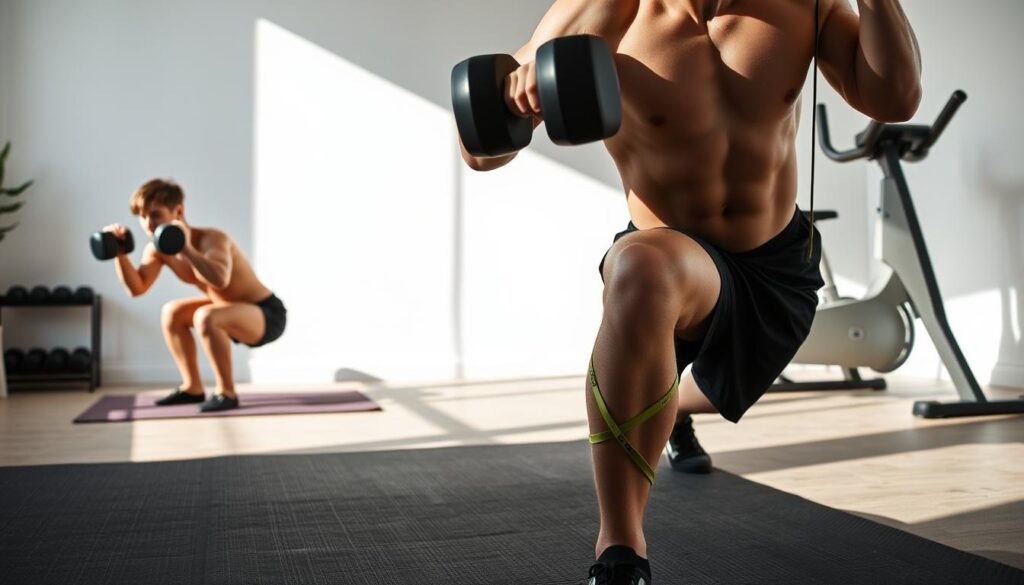
Circuit Structure and Timing Protocols
The circuit has 4-6 exercises done one after another with little rest. Each exercise lasts 30-45 seconds, then rest for 15-30 seconds. Repeat for 15-20 minutes, adjusting as needed.
Exercise Combinations for Maximum Calorie Burn
For more calorie burn, mix exercises that work many muscles at once. Try dumbbell squats with resistance band chest presses or resistance band rows with dumbbell lunges. These compound exercises burn more calories and build muscle endurance.
Recovery Strategies Between Circuit Sessions
Rest well between HIIT sessions. Take at least 48 hours off before doing the same circuit again. Eat well and drink plenty of water to help your muscles recover.
Creating a Weekly Home Workout Schedule for Consistent Results
To get consistent results from home workouts, a good weekly schedule is key. A well-planned routine makes sure you hit all major muscle groups. It also gives you enough time to recover.
Think about your fitness level and goals when setting up your schedule. This will help you pick the best workout for you.
Beginner 3-Day Split Program
Starting with a 3-day split program is a smart move for beginners. It focuses on big muscle groups like legs, chest, and back. Include exercises like:
- Dumbbell squats for lower body strength
- Resistance band push-ups for upper body development
- Dumbbell rows for back and core strength
Here’s a sample 3-day split program:
- Day 1: Lower body workout (dumbbell squats, calf raises)
- Day 2: Upper body workout (resistance band push-ups, dumbbell rows)
- Day 3: Total body workout (dumbbell and resistance band HIIT circuit)
Advanced 5-Day Split Program
For those with more experience, a 5-day split program is a step up. It offers more focused training and includes a variety of exercises with dumbbells and resistance bands.
Here’s a sample 5-day split program:
- Day 1: Chest and triceps (resistance band push-ups, dumbbell extensions)
- Day 2: Back and biceps (dumbbell rows, resistance band curls)
- Day 3: Legs (dumbbell squats, lunges)
- Day 4: Shoulders and abs (dumbbell shoulder press, resistance band rotations)
- Day 5: Total body workout (dumbbell and resistance band HIIT circuit)
Nutrition Tips to Complement Your Home Fitness Routine
Nutrition is key to reaching your home fitness goals. It helps whether you’re just starting or are already advanced. A good nutrition plan boosts your workout and helps you recover. It’s important to eat right when using dumbbells and resistance bands to get the most out of your exercises.
Pre and Post-Workout Nutrition Basics
Knowing the basics of pre and post-workout nutrition is crucial. Before working out, eat a meal with protein and carbs for energy. A good choice is chicken, brown rice, and veggies.
After your workout, eat a mix of protein and carbs within 30-60 minutes. This helps your muscles recover and grow.
Hydration and Recovery Nutrition
Drinking enough water is vital for performance and recovery. Drink water before, during, and after your workouts to avoid dehydration.
Also, add recovery nutrition like shakes or meals with lots of protein to help muscles repair. Electrolyte drinks are great for intense or long workouts.
Conclusion
Adding the 5 proven fitness at home exercises to your routine can really boost your fitness. Using dumbbells and resistance bands helps you get stronger and improve. Remember, being consistent and patient is key to reaching your health goals.
Doing exercises like dumbbell squats and resistance band push-ups at home is easy. It makes sticking to your workout plan simpler. With the right tips, you can see great results and live a healthier life.
Combine these exercises with a good routine and healthy eating to reach your fitness goals. Start today and see how effective home workouts can change your life.


